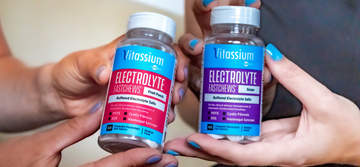
Cystic fibrosis (CF) is a progressive, genetic condition most commonly recognized for its effects the lungs, where thick mucus clogs air passageways over time and eventually becomes life-threatening. Less well-known is CF’s harmful effects on the digestive system and sweat glands, leading to malnutrition and increased risk for dehydration during exercise or illness.
While these symptoms may seem unrelated, they actually have a common cause: salt. Or, more specifically, a genetic mutation that impacts how cells process salt, which disrupts the flow of electrolytes and water throughout the body.
WHAT CAUSES CF?
People living with CF have a mutation in their cystic fibrosis transmembrane conductance regulator (CFTR) gene, which is responsible for producing a protein that sits on the surface of our cell membranes and helps regulate the flow of chloride ions into and out of the cell. (Chloride ions are formed when our bodies break down salt into its basic components: sodium and chloride.)
Nature abhors imbalance, so our bodies try and keep the concentration of chloride ions equal across cell membrane at all times. In a healthy person, this means that when too many chloride ions build up inside the cells, the CFTR protein will release excess chloride ions out into the body, until the total concentration of chloride ions inside and outside the cells becomes equal.
However, for people living with CF, the CFTR protein doesn’t work properly, so chloride ions are not able to escape the cell efficiently. But the body still wants to correct the imbalance, so instead, things work in reverse. Rather than push excess chloride ions out of the cell, the body draws water in, diluting the internal concentration of chloride ions until levels are again balanced.
As a result, there is not enough water outside the cells to form the mucus that lines the lungs and certain portions of the digestive tract. Over time, this mucus becomes dry and thick, preventing the flow of air and nutrients.
WHAT CAUSES CF SYMPTOMS?
When mucus is not able to form properly, several symptoms result:
Blocked lungs: The most well-known symptom of CF is the blocked airways that result from dried mucus that builds up over time.
Increased risk for infection: Our bodies rely on mucus to capture harmful bacteria and pathogens we inhale when breathing. Once these invading substances become trapped in the sticky mucus, tiny cells known as cilia move them to the back of the throat, where they can be swallowed and killed by stomach acid. However, when the mucus is too thick, the cilia cannot do their job efficiently, and pathogens aren’t removed from the lungs fast enough to prevent infection. Thus, people living with CF are at a much higher risk for respiratory infections; ultimately these infections are the most-common cause of death from CF.
Malnutrition: Our bodies also produce mucus to transport digestive juices into the small intestine to help break down food. As with the lungs, CF can cause these passageways to become blocked, which prevents the body from absorbing enough nutrients.
Salty sweat: The final, common symptom of CF is salty skin. In fact, measuring the amount of chloride in a person’s sweat is the most reliable way to diagnose CF, according to the Cystic Fibrosis Foundation. It’s also commonly believed that doctors as far back as the medieval period predicted an early death for infants with salty skin, even though CF had not been discovered yet.
The reason CF leads to such high concentrations of salt in sweat again goes back to the mutated CFTR gene. Sweat glands are tiny chambers under the skin, connected to the surface by a small tube. When the body becomes heated, these glands pump salt into the chambers, which draws water in through the chamber’s “walls.” (Remember, our bodies hates an imbalance.) With more water inside the chamber, the internal pressure rises, and the water and salt mixture is forced through the tube to the surface of the skin, where the water can evaporate and cool us off.
In a healthy person, the sweat glands reabsorb most of the salt before it reaches the skin so it can be reused over time. However, for a person living with CF, the malfunctioning CFTR protein prevents the salt from being reabsorbed appropriately, meaning far more salt than necessary is released through sweat. This rapidly depletes stores of electrolytes during exercise, illness or time spent in a hot environment.
When salt levels become too low, people are at risk for a condition called hyponatremia, which is characterized by headaches, nausea, muscle weakness and cramping. To avoid these outcomes, people living with CF are advised to consume extra salt throughout the day, particularly before, during and after exercise. Exact levels depend on age, but recommendations can be up to three times as much as those needed by a healthy person.
WHAT ARE SOME EASY WAYS TO CONSUME MORE SALT?
It’s best to work with a doctor to figure out the best option for you, but common methods of boosting salt intake through diet include:
- Choosing the “salty” version of foods such as soups, chips or crackers
- Drinking broth with meals instead of water
- Liberally adding salt to salads, sandwiches or other savory meals
- Keeping a salt shaker at your desk, in your lunchbox or wherever you usually eat outside the home
If you’re struggling to get enough sodium into your diet through salty foods, you may find supplements like SaltStick Electrolytes® can make things easier by providing concentrated forms of electrolytes in forms that are easily absorbed by your body without leading to stomach upset. SaltStick Electrolytes are specifically formulated to provide a similar ratio of electrolytes to what your body loses through sweat.
If you live in the U.S. and you want to learn more about SaltStick, consider the Vitassium Club. It’s free to join, and as a member, you’ll get access to a 25% discount on all our products, along with free shipping on orders worth $50 or more. Learn more about the Vitassium Club here.
Disclaimer: Contact your physician before starting any exercise program or if you are taking any medication. Individuals with high blood pressure should also consult their physician prior to taking an electrolyte supplement. Overdose of electrolytes is possible, with symptoms such as vomiting and feeling ill, and care should be taken not to overdose on any electrolyte supplement.







